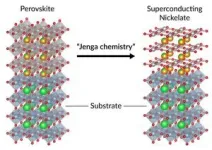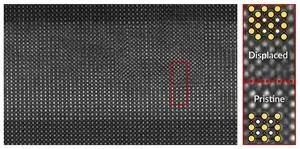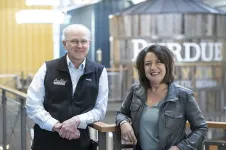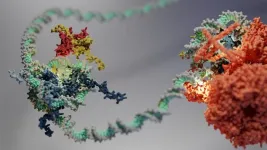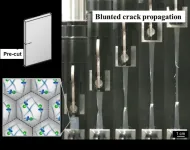(Press-News.org) LAWRENCE, Kan. — Around 14 million tons of plastic end up in the ocean every year. But that is not the only water source where plastic represents a significant intrusion.
“We found microplastics in every lake we sampled,” said Ted Harris, associate research professor for the Kansas Biological Survey & Center for Ecological Research at the University of Kansas.
“Some of these lakes you think of as clear, beautiful vacation spots. But we discovered such places to be perfect examples of the link between plastics and humans.”
Harris is one of 79 researchers belonging to the international Global Lake Ecological Observatory Network (GLEON), which examines processes and phenomena occurring in freshwater environments. Their new paper, titled “Plastic debris in lakes and reservoirs,” reveals that concentrations of plastic found in freshwater environments are actually higher than those found in so-called “garbage patches” in the ocean. The article is published in Nature.
For his role, Harris teamed with Rebecca Kessler, his former student and recent KU graduate, to test two Kansas lakes (Clinton and Perry) and the Cross Reservoir at the KU Field Station.
“That entailed us going out, tolling a net with tiny little holes in it, dragging it for about two minutes, then collecting those samples of microplastics and sending them off to (the lead researchers),” Kessler said.
The research project was designed and coordinated by the Inland Water Ecology and Management research group of the University of Milano-Bicocca, Italy (headed by Barbara Leoni and Veronica Nava). The team sampled surface waters of 38 lakes and reservoirs, distributed across gradients of geographical position and limnological attributes. It detected plastic debris in all studied lakes and reservoirs.
“This paper essentially shows the more humans, the more plastics,” Harris said. “Places like Clinton Lake are relatively low in microplastics because — while there are many animals and trees — there aren’t a lot of humans, relative to somewhere like Lake Tahoe where people are living all around it. Some of these lakes are seemingly pristine and beautiful, yet that’s where the microplastics come from.”
Harris said that many of the plastics are from something as outwardly innocuous as T-shirts.
“The simple act of people getting in swimming and having clothing that has microplastic fibers in it leads to microplastics getting everywhere,” he said.
The GLEON study cites two types of water bodies studied that are particularly vulnerable to plastic contamination: lakes and reservoirs in densely populated and urbanized areas; and those with elevated deposition areas, long water retention times and high levels of anthropogenic influence.
“When we started the study, I didn’t know a lot about microplastics versus large plastics,” Harris said.
“When this paper says ‘concentrations as much or worse than the garbage patch,’ you always think of the big bottles and stuff, but you’re not thinking of all that smaller stuff. You don’t see a huge garbage patch in Lake Tahoe, yet it’s one of the most impacted lakes when it comes to microplastics. Those are plastics you can’t really see with the naked eye, and then you get underneath a scope at 40,000x, and you see these little jagged pieces and other particles that are the same size as algae or even smaller.”
Part of Harris and Kessler’s enthusiasm for taking part in this project was to highlight a region of the U.S. that is often overlooked.
“In this study, there’s one dot in the middle of the country, and that’s our sample,” he said. “In Iowa, Missouri and Colorado, there’s this huge swath of area that has water bodies, but we often don’t get them into those massive global studies. So it was really important for me to put Kansas on the map to see and contextualize what these differences are in our lakes.”
Harris has worked at KU since 2013, where his research focuses on aquatic ecology. Kessler graduated KU in 2022 with a degree in ecology, evolutionary & organismal biology.
“The biggest takeaway from our study is that microplastics can be found in all lakes,” Kessler said. “Obviously, there are different concentrations. But they are literally everywhere. And the biggest contributing factor to these microplastics is human interaction with the lakes.”
Top photo: Rebecca Kessler samples water for microplastics in Clinton Lake, Lawrence. Photo by Ted Harris.
END
Global study details microplastics contamination in lakes and reservoirs
2023-07-12
ELSE PRESS RELEASES FROM THIS DATE:
A foundation that fits just right gives superconducting nickelates a boost
2023-07-12
Researchers at the Department of Energy’s SLAC National Accelerator Laboratory and Stanford University say they’ve found a way to make thin films of an exciting new nickel oxide superconductor that are free of extended defects.
Not only does this improve the material’s ability to conduct electricity with no loss, they said, but it also allows them to discover its true nature and properties, both in and out of the superconducting state, for the first time.
Their first look at a superconducting nickel oxide, or nickelate, that does ...
New study using human fibroid cells supports use of green tea compound as treatment for uterine fibroids
2023-07-12
In a pre-clinical, proof-of-concept study from Johns Hopkins Medicine, researchers found that epigallocatechin gallate (EGCG), a green tea compound with powerful antioxidant properties, could be promising for both treating and preventing uterine fibroids. Results of the study, first posted online May 25 in Scientific Reports, add to growing evidence that EGCG may reduce fibroid cell growth. The study was specifically designed to identify the biochemical mechanisms responsible for EGCG action in fibroid cells.
The investigators emphasize that their study involves human fibroid cells grown in the laboratory and treated with EGCG extract to explore the possibility of oral EGCG supplementation ...
The good advice that could lift people out of poverty
2023-07-12
Providing access to housing, debt, and benefit advice within food banks could help lift people out of poverty - according to a University of East Anglia study.
Researchers worked with Norwich Foodbank centres, part of the Trussell Trust, on a pilot project that saw representatives from Citizens Advice and Shelter posted within the service.
The ‘Making a Difference’ initiative meant that people forced to use a food bank were also able to access advice on a range of issues - from housing and debt to benefits.
It is now hoped that this scheme will be rolled out to foodbanks nationally.
Lead researcher Dr Sarah Hanson, from UEA’s School of ...
Amplified Sciences receives $400,000 NCI grant to improve early detection of pancreatic cancer
2023-07-12
WEST LAFAYETTE, Ind. – Health care providers and their patients could know with greater confidence whether pancreatic cysts are benign or potentially malignant, and if surgery is required to remove them, by using a new diagnostic test currently in development.
Amplified Sciences, a clinical-stage life sciences diagnostic company that licenses Purdue University innovations, has received a Phase I Small Business Innovation Research, or SBIR, grant of approximately $400,000 from the National Cancer Institute (NCI) to develop the test. The company focuses on accurately detecting and categorically assessing the risks of debilitating ...
Birmingham start-up awarded funding for technology that generates water out of air
2023-07-12
NovNat Tech Ltd, a visionary new company based in the Unit 9 incubator at the Birmingham Research Park, has secured funding from Innovate UK to develop a novel technology that can generate water out of air.
NovNat Tech is offering solutions to one of the most critical problems of today and the future, the global water scarcity crisis, and is developing a first of its kind ‘atmospheric water harvester’ to help address the global water shortage.
The harvest uses a proprietary material that has already been ...
Webb celebrates first year of science with close-up on birth of sun-like stars
2023-07-12
From our cosmic backyard in the solar system to distant galaxies near the dawn of time, NASA’s James Webb Space Telescope has delivered on its promise of revealing the universe like never before in its first year of science operations. To celebrate the completion of a successful first year, NASA has released Webb’s image of a small star-forming region in the Rho Ophiuchi cloud complex.
“In just one year, the James Webb Space Telescope has transformed humanity’s view of the cosmos, peering ...
Lupus Research Alliance announces recipients of 2023 Diversity in Lupus Research Awards
2023-07-12
NEW YORK, NY, July 12. The Lupus Research Alliance is pleased to announce the 2023 recipients of the Career Development and Postdoctoral Awards to Promote Diversity in Lupus Research. The Diversity in Lupus Research Awards aim to foster the development of outstanding, underrepresented minority scientists and establish a diverse community of researchers and clinicians in the field of lupus.
Lupus is a debilitating autoimmune disorder, and the prevalence, severity of symptoms, and mortality are higher among people of color. Yet a recent report by the National Science Foundation showed that while “Blacks or African Americans, Hispanics or Latinos, ...
A glimpse into the hexasome: 40 years on
2023-07-12
In 1983, scientists discovered hexasomes – a unique molecular structure that helps cells package their DNA. Now, a study conducted by the Eustermann group at EMBL Heidelberg has shed light on how DNA packaging into hexasomes can affect the function of enzymes involved in gene regulation.
DNA: a lot to unpack
DNA is a very long, thin thread containing our genetic instructions. Being much longer than the tiny space inside our cells, it needs a clever packaging system. That’s where nucleosomes come into play – tiny spool-like structures that help compact our genetic information. Multiple nucleosomes are then linked ...
Award for dementia researcher from New York City
2023-07-12
This year’s “Hartwig Piepenbrock-DZNE Prize”, endowed with 60,000 euros, goes to the British neuroscientist Alison Goate, DPhil. The award recognizes her outstanding contributions to research into Alzheimer’s disease and frontotemporal dementia. Professor Goate researches and teaches at the Icahn School of Medicine at Mount Sinai, an international leader in biomedical education, research, and patient care located in New York City. The prize is presented jointly by the Piepenbrock Group and the German Center for Neurodegenerative Diseases (DZNE). The award ...
Towards crack-resistant nanoparticle-based latex films
2023-07-12
Synthetic polymer materials, such as plastics and rubbers, have become ubiquitous in our daily lives. It is, therefore, essential to ensure that they are safe, durable, and sustainable. This is especially true for synthetic latex films, which are widely used in packaging, biomedicine, and electronics.
But what exactly are synthetic latex films? Simply put, they are a type of nanoparticle-based films that are produced by drying out a mixture of polymer nanoparticles and water. As the solvent evaporates, the nanoparticles become more packed until finally the interactions between polymer chains at the boundaries of nanoparticles create a coherent film. Unfortunately, the latex films ...

